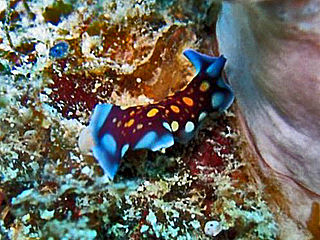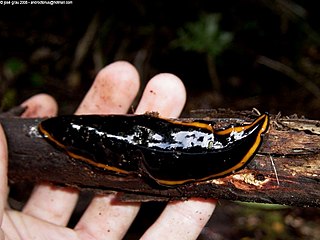
The flatworms, flat worms, Platyhelminthes, or platyhelminths are a phylum of relatively simple bilaterian, unsegmented, soft-bodied invertebrates. Unlike other bilaterians, they are acoelomates, and have no specialized circulatory and respiratory organs, which restricts them to having flattened shapes that allow oxygen and nutrients to pass through their bodies by diffusion. The digestive cavity has only one opening for both ingestion and egestion ; as a result, the food cannot be processed continuously.
Gnathostomulids, or jaw worms, are a small phylum of nearly microscopic marine animals. They inhabit sand and mud beneath shallow coastal waters and can survive in relatively anoxic environments. They were first recognised and described in 1956.

The Turbellaria are one of the traditional sub-divisions of the phylum Platyhelminthes (flatworms), and include all the sub-groups that are not exclusively parasitic. There are about 4,500 species, which range from 1 mm (0.039 in) to large freshwater forms more than 500 mm (20 in) long or terrestrial species like Bipalium kewense which can reach 600 mm (24 in) in length. All the larger forms are flat with ribbon-like or leaf-like shapes, since their lack of respiratory and circulatory systems means that they have to rely on diffusion for internal transport of metabolites. However, many of the smaller forms are round in cross section. Most are predators, and all live in water or in moist terrestrial environments. Most forms reproduce sexually and with few exceptions all are simultaneous hermaphrodites.

The Polycladida represents a highly diverse clade of free-living marine flatworms. They are known from the littoral to the sublittoral zone, and many species are common from coral reefs. Only a few species are found in freshwater habitats.

Pseudocerotidae is a family of flatworms which includes the Bedford's flatworm.

Pseudoceros is a genus of the flatworms Platyhelminthes.

Geoplanidae is a family of flatworms known commonly as land planarians or land flatworms.
Maritigrella crozierae, the tiger flatworm, is a species of marine polyclad flatworm in the family Euryleptidae. It is found on the eastern coasts of North America and the Caribbean Sea where it feeds on colonial sea squirts.

Pseudoceros bifurcus is a marine flatworm species that belongs to the family Pseudocerotidae.

Pseudoceros ferrugineus, the Fuchsia flatworm, is a marine flatworm species that belongs to the Pseudocerotidae family.
Pseudoceros goslineri, the Gosliner flatworm, is a marine flatworm species that belongs to the family Pseudocerotidae.

Pseudoceros lindae, common name Linda's flatworm, is a marine Flatworm species that belongs to the Pseudocerotidae family.

Thysanozoon nigropapillosum is a species of polyclad flatworms belonging to the family Pseudocerotidae. Some common names include gold-speckled flatworm, marine flatworm, yellow papillae flatworm, yellow-spotted flatworm, and yellow-spotted polyclad flatworm.

Acotylea is a suborder of free-living marine turbellarian flatworms in the order Polycladida.

Müller's larva or Mulleria is a larva of some Polycladida. It has 8-fold symmetry and is somewhat like a ctenophore. Müller’s larva is ciliated and has several paired and unpaired lobes. The cilia on the lobes are longer than cilia on the rest of the body. At the anterior and posterior ends of the larva are tufts of longer cilia. The apical tuft originates from the apical organ, a sensory structure associated with the central nervous system.

Polycladus is a genus of land planarians from South America, currently comprising a single species, Polycladus gayi, which occurs in the Valdivian Forest, Chile.
Diana Marcela Bolaños Rodríguez is a marine biologist from Colombia, who has studied and classified various types of platyhelminths. She was a recipient of the L'Oréal-UNESCO Fellowship for Women in Science in 2010, was selected as Colombian biologist of the year in 2012, and in 2013 was named by the BBC as one of the top ten women in science in Latin America.
Rhabditophora is a class of flatworms. It includes all parasitic flatworms and most free-living species that were previously grouped in the now obsolete class Turbellaria. Therefore, it contains most of the species in the phylum Platyhelminthes, excluding only the catenulids, to which they appear to be the sister group.

Trepaxonemata is a subclass of the Platyhelminthes or flatworms. It includes all parasitic flatworms and several free-living species that were previously grouped in the now obsolete class Turbellaria. Therefore, it contains the majority of species in the phylum Platyhelminthes, excluding the Catenulida, and the Macrostomorpha.

Yungia aurantiaca is a species of flatworm in the family Pseudocerotidae. It is found in the temperate northeastern Atlantic Ocean and the Mediterranean Sea.












